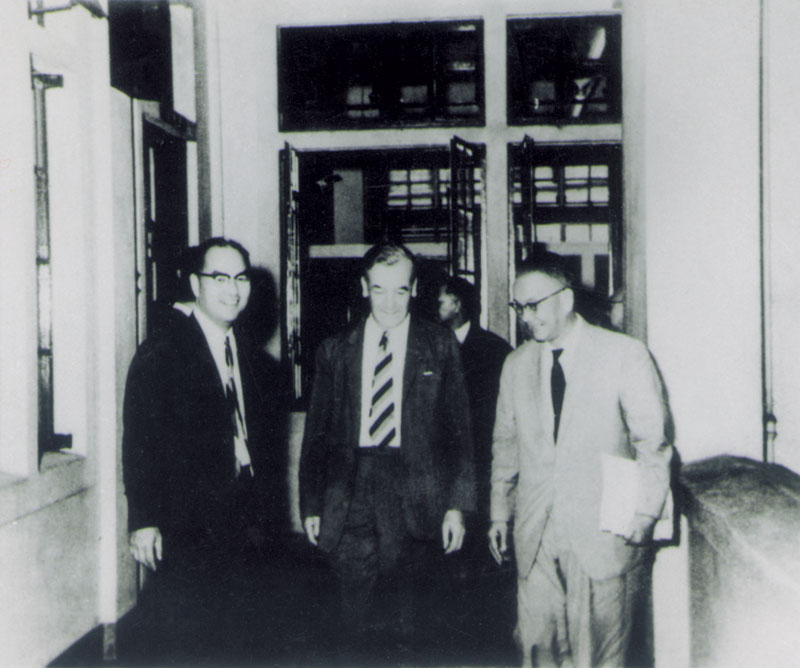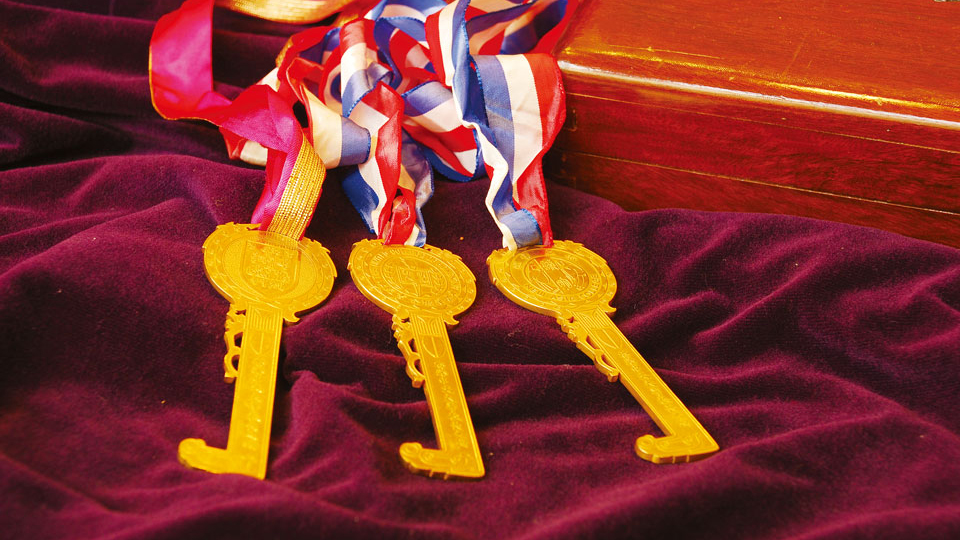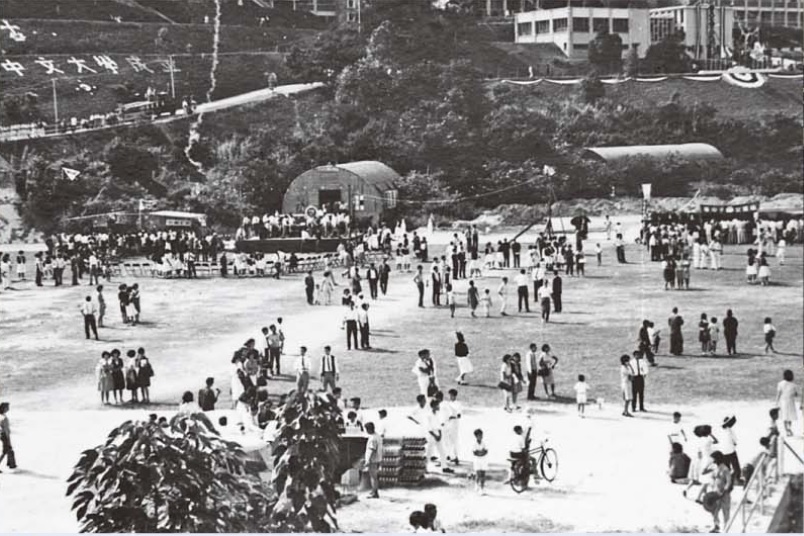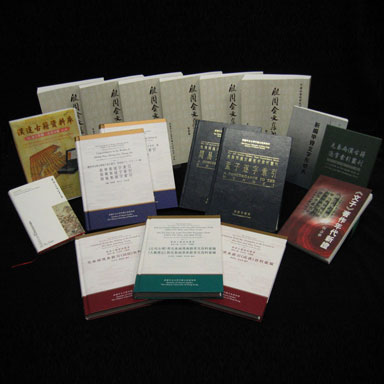The birth of the People’s Republic of China in 1949 saw a wave of migration coming into Hong Kong. Previously, many graduates of Chinese middle schools had returned to the mainland for further education due to a shortage of places in tertiary institutions in Hong Kong. This option became unviable, and it led to a marked surge in demand for higher education with Chinese as the medium of instruction.
At that time, a substantial number of mainland scholars and educators also migrated to Hong Kong. They were committed to the cause of higher education and to preserving and propagating Chinese culture. Despite the lack of resources, they managed to establish schools and colleges in rented premises. Among these were New Asia, Chung Chi and the forerunners of United College, which were to emerge as the three founding members of The Chinese University of Hong Kong.
This zone introduces the historical background of three founding Colleges and the road to the establishment of CUHK, including:
Chung Chi College
Chung Chi College was founded in 1951 by Bishop Ronald Hall, Head of the Anglican Church in Hong Kong, Dr Lee Ying-lin, President of former Lingnan University in Guangzhou, and Mr David Au, Chairman of the Board of former St. John’s University in Shanghai. It represented the Christian churches’ commitment to the continuous development of higher education in China and thus gained broad support from Christian organisations and various communities such as the Asia Christian Colleges Association from the UK, the United Board for Christian Higher Education in Asia and the Trustees of Lingnan University from the US.
In 1955, the College was formally incorporated under an ordinance of the Hong Kong government. In 1956, it moved to its permanent site in Ma Liu Shui, a land lot granted by the government. Thereafter, Chung Chi College was able to embark on a steady path of development.

Founders of Chung Chi College (from left): Bishop Ronald Hall, Mr Lee Ying-lin and Mr David Au (1951)

The faculty and staff (1954)

The first graduation ceremony (1955)

The Ma Liu Shui campus under construction (1956)

Foundation stone laying ceremony of the new campus of Chung Chi College (1956)

List of successful candidates in the first entrance examination of the Chung Chi College (1951)

Rt. Rev. Ronald Owen Hall's circular regarding the founding of a Christian college (1951)

Stamp pad and abacus, the stationery used in the early days of Chung Chi College (1951)

Programme of the foundation stone laying ceremony for the new campus of Chung Chi College in Ma Liu Shui (1956)

The school-bell on the campus in Ma Liu Shui (1950s-1960s)
New Asia College
New Asia College started out as the Asia Evening College of Arts and Commerce, founded in 1949 by the eminent scholars Dr Ch'ien Mu, Mr Tang Chun-i and Mr Tchang Pi-kai among others. Their mission was to carry on their educational ideals of promoting Chinese humanism and facilitating cultural exchange between East and West. The early days of the College were tough but the mission and educational vigour of the New Asia pioneers gradually drew attention from many quarters. It soon received financial support from various channels, the most prominent one being the Yale-in-China Association. It also received funding from the Asia Foundation and the Harvard-Yenching Institute. Such sponsors gave the College a solid foundation that spurred its growth.

New Asia College at Kweilin Street (1950)

The first New Asia College graduation ceremony (1952)

Faculty members at the General Assembly of Members, New Asia College (1957)
Front row, from right: Mr Yang Ju-mei, Mr Shen Yen-mou, Mr Ch'ien Mu, Mr Vermier Y. Chiu, Mr Tsai Ching-yan, Mr Hu Jia-jian
Back row, from right: Mr Chu Kwong-kwok, Mr Tang Chun-i, Mr Tchang Pi-kai, Mr Wang Shu-ling, Mr Wu Chen-hsiung

Plaque commemorating completion of the first phase of Farm Road Campus, a gift of the Yale-in-China Association (1956.10.11)

New Asia College campus on Farm Road

Graduation diploma of Professor Yu Ying-shih (1952)

Letter from Mr Tang Chun-i, the Registrar, in response to a student’s enquiry about studying in Taiwan (1958)

Student identity card of New Asia College (1961) (Courtesy of Mr. Lee Kam-chung)

Xin Ya Yi Duo–On the vision and mission of New Asia College (1989)
United College
United College came into being through the amalgamation of five colleges: Ping Jing College of Accountancy, Wah Kiu, Canton Overseas, Wen Hua and Kwang Hsia. Apart from Ping Jing which was founded in Hong Kong, the other four were private colleges which had moved south either from Guangzhou or its vicinity, bringing with them their students and teachers. These colleges operated in spartan premises in the evenings, relying precariously on their alumni in Hong Kong for funding. In early 1956, when Professor Grayson Kirk, President of Columbia University and Director of the Asia Foundation, visited Hong Kong and learnt of the hardship of these colleges, he suggested amalgamation. Subsequently the five colleges announced in June the same year that they would join together to form the United College of Hong Kong. United College continued to receive financial support from the Asia Foundation and the Mencius Foundation. Later, the government made available premises on Bonham Road to serve as its campus. Within a few years, it had developed into a well-established post-secondary college.

Campus of United College on Caine Road (1956-61)

Presidents of the five colleges that made up United College on the Caine Road campus: (from left) Dr Wang Yu-kai, President of Kwang Hsia College; Professor Zhu Meng-tan, President of Wen Hua College; Dr Chen Ping-chuan, President of Canton Overseas College; Professor Wang Shu-tao, President of Wah Kiu College and Dr Huang Wen-gun, President of Ping Jing College of Accountancy (1956)

The first graduation ceremony of United College (1957)

Campus of United College on Bonham Road (1962-71)

A page from the inaugural issue of United College News (1957)

Financial budget of the first academic year of United College (1956)

United College–An Overview (1957)

Board of Trustees, United College (1957)

Watermark of United College (1956-1963)
Striving for the Establishment of a Chinese University
In 1957, the three colleges formed the Chinese Colleges Joint Council, chaired by Dr F.I. Tseung, President of United College, with the aim of gaining degree-awarding status for the three colleges. In 1958, the government accepted the proposal for the establishment of a Chinese university, and in the following year, officially announced its subvention to the three colleges, which were to become the founding colleges of the new university.
The period between 1959 and 1963 saw the transition of the colleges to a university in status and form. New Asia College, Chung Chi College and United College worked jointly to develop the curricula and improve the facilities in each college.
In 1960, Sir John Fulton, who was the Vice-Chancellor of the University of Sussex at the time, was invited to come to Hong Kong as a consultant on the project. In his Report on the Development of Post-Secondary Colleges in Hong Kong, he emphasized the importance of academic freedom and research, and endorsed the new university’s use of Chinese as the medium of instruction as well as its role as a bridge for cultural exchange. In 1961, the government appointed a University Preparatory Committee, chaired by Sir Cho-yiu Kwan, to advise on sites and buildings for the University. Fulton returned in 1962, to chair a committee comprising international academics to examine the standard of the three colleges and lay down the structure of the new university.

A newspaper clipping on the amalgamation of the three colleges to form the University (1959.6)

Mr Leonard Geoffrey Morgan, Deputy Director of Education, visiting Chung Chi College (1959)

Fulton Commission formed (1962)

Report of the Fulton Commission (1963)
The Founding of The Chinese University of Hong Kong
In 1963, the Report of the Fulton Commission was published and it clearly proposed a federal type of governance for the amalgamated colleges, which served as the blueprint and basis of the founding of the Chinese University. The Government accepted the recommendations of the Commission. The Chinese University of Hong Kong Ordinance came into effect in September that year. Sir Cho-yiu Kwan was appointed the first Chairman of the University Council. Dr Choh-ming Li was appointed the first Vice-Chancellor of the University.
On 17 October, Sir Robert Black, the Governor of Hong Kong and Chancellor of the University, presided over its inauguration ceremony at the Hong Kong City Hall. From colleges to university, a 14-year journey fraught with difficulties reached a rewarding end, and Chinese language and culture finally achieved official recognition in Hong Kong.

Vice-Chancellor Dr Choh-ming Li with presidents of the three founding Colleges at the reception celebrating the establishment of The Chinese University of Hong Kong and the new Vice-Chancellor. (1963.11.7)

The Chinese University of Hong Kong Ordinance (1963)

New Asia College's Proposal of adopting 'Bo Wen Yue Li–Through learning and temperance to virtue' as the Chinese University's motto (1964)

Coat of arms of The Chinese University of Hong Kong (1967)

The satin bearing signatures of guests attending the reception held by the faculty and staff of the three foundation colleges to celebrate the establishment of The Chinese University of Hong Kong and the new Vice-Chancellor, Dr Choh-ming Li. (1963.11.7)

Seal of the Vice-Chancellor of The Chinese University of Hong Kong (1964)

Ceremonial keys of the three founding Colleges presented to the Vice-Chancellor of The Chinese University of Hong Kong (1964)
Next Zone ...Themes | Zone C
Excellence in Education
News
CUHK History Gallery will be temporarily closed on 4th March 2024 PM for University Event.
23 February 2024
The CUHK History Gallery will reopen on 20th September 2023.
For opening hours, please refer to Visitor Info page
21 June 2023

Mon to Wed, Fri, Sat: 10am - 5pm
Sun: 12pm - 5pm
Thu and Public Holidays: Closed














